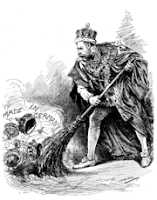 Three years into the Great War, anti-German feeling was running high in Britain. To appeal to nationalist sentiment King George V decided to change the name of the British royal house to the House of Windsor from the Germanic sounding House of Saxe-Coburg and Gotha, which had been the house of the royal family since Queen Victoria married Prince Albert, son of the Duke of Saxe-Coburg and Gotha. The new, quintessentially English, name is that of a town to the west of London with a long history of royal connections not least because of the castle there, which is one of the royal residences.
Three years into the Great War, anti-German feeling was running high in Britain. To appeal to nationalist sentiment King George V decided to change the name of the British royal house to the House of Windsor from the Germanic sounding House of Saxe-Coburg and Gotha, which had been the house of the royal family since Queen Victoria married Prince Albert, son of the Duke of Saxe-Coburg and Gotha. The new, quintessentially English, name is that of a town to the west of London with a long history of royal connections not least because of the castle there, which is one of the royal residences.So, on 17th July 1917, George V issued an Order-in-Council that decreed that everyone descended from Queen Victoria would change surname to Windsor, excluding any married women and their children (and those who were on the German side - not least his cousin, the German monarch Kaiser Wilhelm II - who were to be ostracized). Furthermore, he also relinquished all of his German titles and those of the members of the newly renamed House of Windsor. Many of George's male relatives who lost German aristocratic titles received British peerages in compensation, thus his cousin, Prince Louis of Battenberg, became 1st Marquess of Milford Haven and took the surname Mountbatten, which is an Anglicisation of Battenberg.
The text of the King's proclamation is available on the Heraldica website.
Related posts
Scottish monarch crowned King of England: 25th July 1603
Coronation of William IV: 8th September 1831
Queen Victoria`s first train journey: 13th June 1842